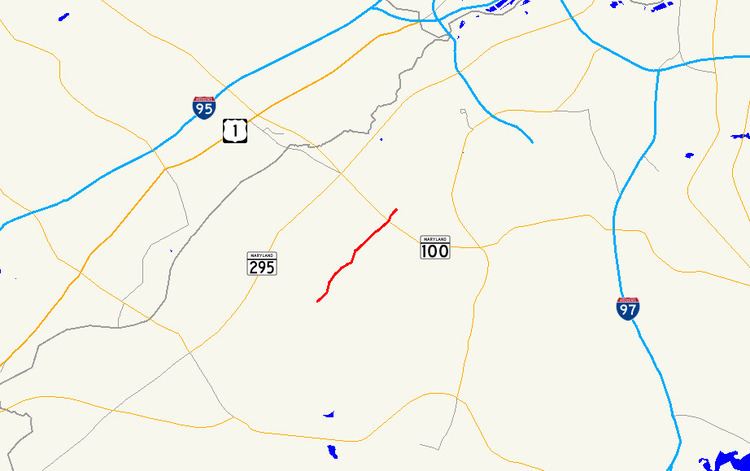Existed: 1946 – present Length 4.91 km | Counties: Anne Arundel Constructed 1946 | |
 | ||
County | ||
Maryland Route 713 (MD 713) is a state highway in the U.S. state of Maryland. The highway runs 3.05 miles (4.91 km) from an entrance to Fort George G. Meade north to MD 176 in Hanover. In addition to serving as an access point to the U.S. Army installation, MD 713 provides the primary access to the Arundel Mills regional shopping center and the Maryland Live! Casino. MD 713 was constructed as part of MD 175 in the late 1920s and received its present designation in the mid-1940s. The northern end of the highway was relocated in the mid-1990s for the construction of MD 100 and modified again when Arundel Mills was built a few years later. One of MD 713's auxiliary routes connects the mall and casino with MD 295 via the first diverging diamond interchange in Maryland.
Contents
Map of MD-713, Hanover, MD 21076, USA
Route description
MD 713 begins just north of the Rockenbach Road entrance to Fort Meade. The state highway heads north as a five-lane road with center turn lane to its intersection with MD 175 (Annapolis Road) in the hamlet of Provinces. MD 713 heads north from MD 175 as two-lane Ridge Road through residential subdivisions. At Stoney Run Drive, the state highway expands to a four-lane divided highway and enters a commercial area. MD 713 passes Ridge Chapel Road, part of the old alignment of MD 713, before reaching an intersection with Arundel Mills Boulevard, which heads southwest to an interchange with MD 295 (Baltimore–Washington Parkway), and Arundel Way, an entrance to Arundel Mills and the Maryland Live! Casino. MD 713 turns north onto Arundel Mills Boulevard, a six-lane divided highway, toward an interchange with MD 100 (Paul T. Pitcher Memorial Highway). The state highway reaches its northern terminus just north of the MD 100 interchange at MD 176 (Dorsey Road). New Ridge Road continues straight as a county highway toward a collection of industrial and business parks in Hanover.
History
Ridge Road was constructed as a concrete road between Provinces and MD 176 in 1929. The highway was originally the easternmost part of MD 175. MD 713 was assigned to Ridge Road by 1946 after MD 175 had been extended southeast toward Odenton. MD 713 was widened between MD 175 and MD 176 in 1951. The highway was extended south from MD 175 to its present terminus at the entrance to Fort Meade in 1967. MD 713 was relocated and expanded to a multi-lane divided highway from south of Ridge Chapel Road to the intersection of New Ridge Road and Ridge Road north of MD 176 in 1995 in conjunction with the construction of MD 100 and the interchange between the two highways. A section of New Ridge Road remained part of MD 713 until the state highway was truncated at MD 176 in 1999. The old alignment of Ridge Road became part of MD 713B (Ridge Chapel Road) and all of MD 713C (Teague Road) south of MD 100, and MD 713D (Ridge Road) north of MD 100 to MD 176. The newly relocated section of MD 713 was relocated again in 2000 with the construction of Arundel Mills Boulevard to create a four-way intersection between the boulevard, the Ridge Road segment of MD 713, and an entrance to Arundel Mills, which opened the same year.
Junction list
The entire route is in Anne Arundel County.
Auxiliary routes
MD 713 has five unsigned auxiliary routes and one former auxiliary route. MD 713A through 713E are associated with the construction of MD 100 through Hanover in the 1990s. MD 713F was assigned as part of the project to connect Arundel Mills Boulevard with MD 295.
